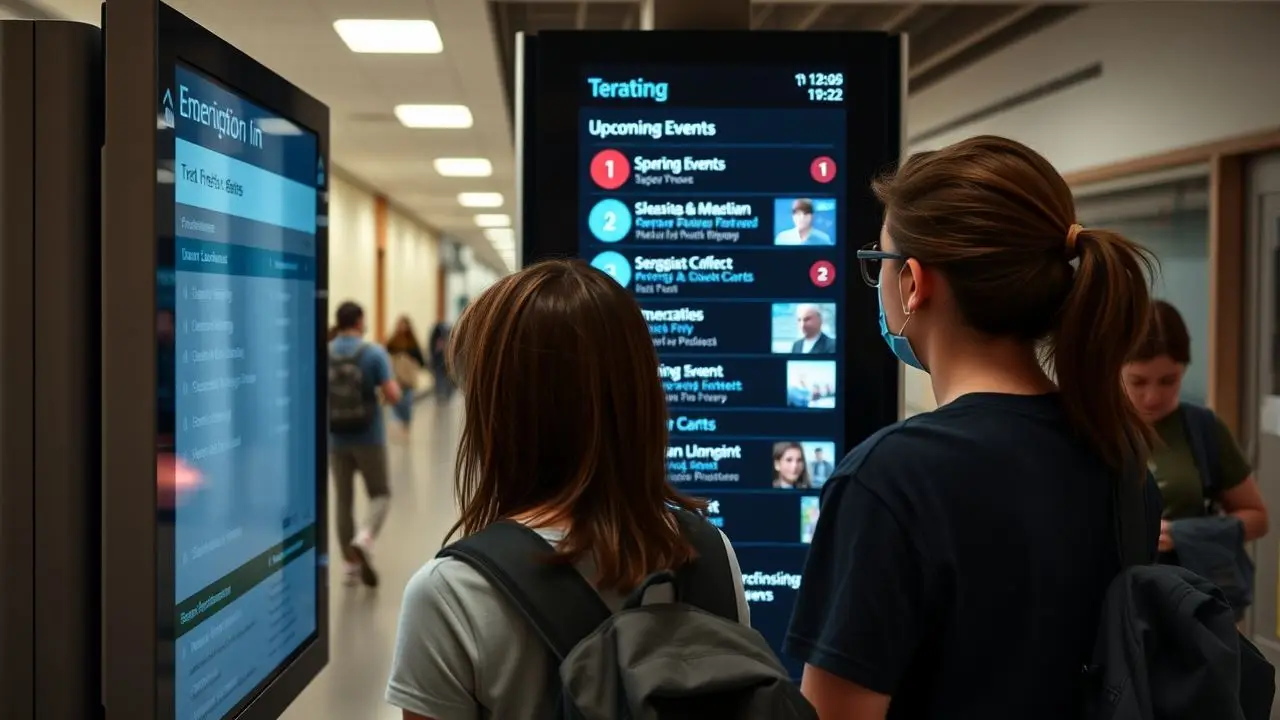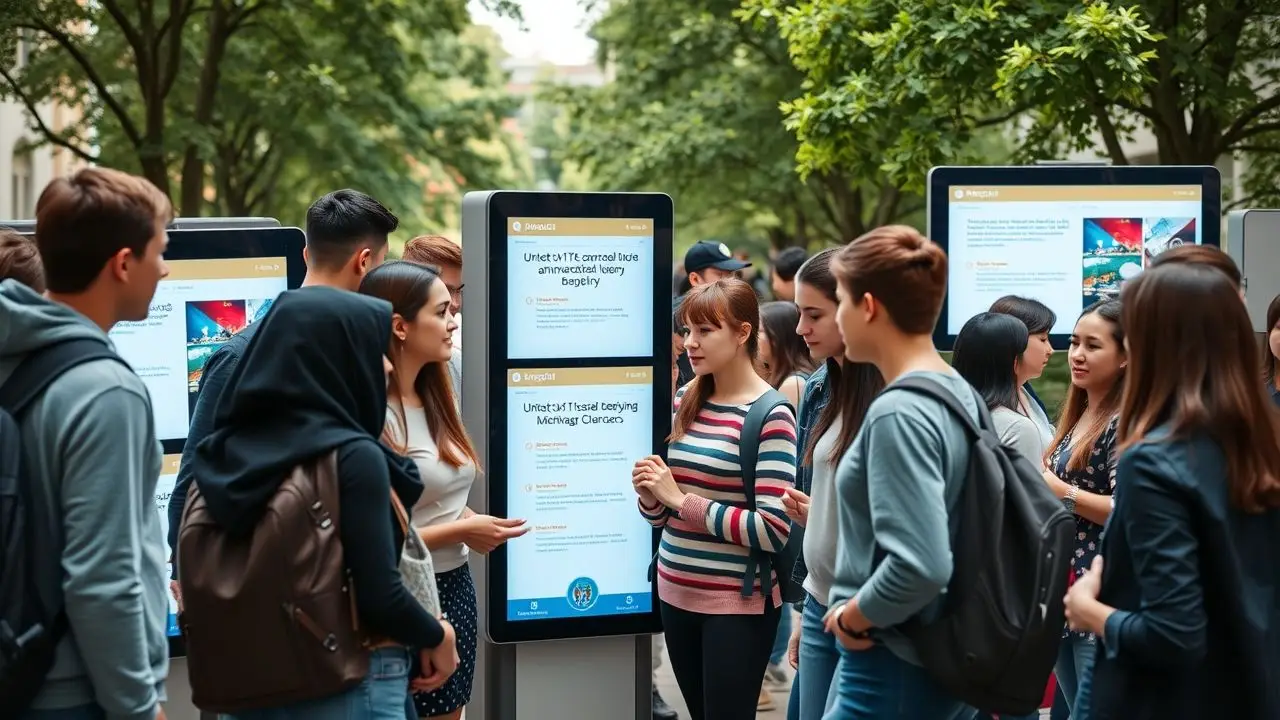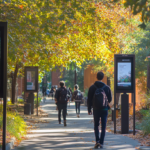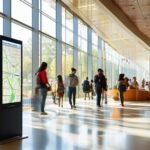Finding the right way to share information on college campuses can be hard. Digital signage offers a modern solution. This guide will show how digital signs improve campus communication and student engagement.
Keep reading to learn more!
Key Takeaways
- Digital signage keeps students informed and engaged. It shares news, events, and emergency alerts quickly.
- Screens like interactive kiosks and video walls make campus life fun. They show maps, events, and social media feeds.
- Using a content management system helps manage what shows on screens. This keeps the information fresh and relevant.
- Safety on campus improves with digital signs. They give out urgent messages fast during emergencies.
- Future trends include more touchscreens and virtual reality. These will create new ways for students to learn and explore campus.
Table of Contents
ToggleBenefits of Digital Signage for College Campuses

Digital signage brings many advantages to college campuses. It helps share important information quickly and keeps students engaged in campus life.
Event promotion

Event promotion is key for college campuses. Digital signage makes it easy to share information about upcoming events. Posters can get lost, but screens grab attention quickly. Students walk by and see announcements in real time.
Using digital displays keeps the campus informed about events like concerts or club meetings. Screens can show countdowns and highlights. This helps increase attendance and engagement.
It also creates excitement around activities on campus. First-hand experience shows that students respond well to bright visuals and clear messages.
Wayfinding

Wayfinding helps students and visitors find their way around campus. Digital signage can show maps and directions in real time. This makes it easy to locate classrooms, offices, and events.
Clear signs reduce confusion and save time.
Interactive displays allow users to touch screens for guidance. They can zoom in on specific areas or search for buildings by name. These features improve student engagement with the campus.
Emergency notifications can also be displayed quickly if needed, ensuring safety during critical moments.
Emergency notifications
 Emergency notifications are vital for keeping students and staff safe. Digital signage can quickly display alerts about threats, severe weather, or other urgent issues. This ensures everyone knows what to do in an emergency.
Emergency notifications are vital for keeping students and staff safe. Digital signage can quickly display alerts about threats, severe weather, or other urgent issues. This ensures everyone knows what to do in an emergency.
Fast updates save lives and reduce panic on campus. Clear messages guide people to safe areas or inform them of ongoing risks. By using university digital signage effectively, schools strengthen campus security and enhance communication during crises.
Campus news and updates
Digital signage is a great way to share campus news and updates. It keeps students, staff, and visitors informed about what’s happening on campus. Events like guest lectures or sports games can get attention through bright displays.
Important announcements about class changes or events also reach everyone quickly.
Social media feeds on screens allow people to see real-time updates. With interactive displays, users can explore upcoming activities and learn more about their choices. This interaction boosts engagement within the college community and ensures that important information is seen by all.
Social media feeds
Social media feeds play a key role in campus engagement. They share real-time updates and event promotions. Students can see news from various platforms, like Instagram or Twitter, on digital signs across the campus.
This keeps everyone informed about activities and important announcements.
Interactive digital signage makes these feeds engaging. It allows students to participate by liking or sharing posts right from the display. This kind of communication helps build a vibrant campus community while showcasing school spirit.
Integrating social media into digital signage enhances the overall university communication strategy.
Interactive experiences
Interactive experiences engage students and staff. They make learning fun and exciting. Colleges can place touch-screen kiosks around campus. These kiosks show maps, events, or important news.
Students can find their way easily with wayfinding tools.
Digital signage also allows for real-time updates on events or classes. It keeps everyone informed and connected to campus life. Social media feeds can display student activities too.
This creates a lively atmosphere on campus. Interactive digital signage helps build community and encourages participation among students.
Campus security
Digital signage plays a key role in campus security. It helps keep students and staff safe by quickly sharing important alerts. For example, if there is an emergency, digital signs can show evacuation routes or safety instructions right away.
This real-time communication is crucial during urgent situations.
In addition to alerts, digital displays can highlight security measures around campus. They can promote safety tips like reporting suspicious activities. By using strong content on these screens, schools boost awareness of their safety protocols.
Digital signage also allows for interactive communication about secure areas and building access points on campus. This provides clear information for everyone who needs it.
Building directories
Building directories help students and visitors find their way around campus. These signs list the names of buildings and show where to go for different services. Easy-to-read maps guide people from one place to another.
Using digital signage for building directories makes it even better. Multimedia screens can display real-time updates about events or changes in locations. First-hand experience shows that clear signage cuts down on confusion.
Students spend less time searching for classes or resources when directories are easy to access. Campus branding also benefits as these tools offer a modern look while sharing important information with the community.
Special recognition
Digital signage can highlight special achievements on campus. It helps celebrate students, faculty, and staff who excel in academics or community service. For example, schools can display a “Student of the Month” feature or showcase award winners during events.
This promotes school pride and motivates others to strive for success.
Using digital displays makes recognition quick and easy. They grab attention with bright visuals and moving text. Special announcements can be updated often to keep everyone informed about recent honors or awards.
This innovative solution shows how technology in education enhances communication on college campuses effectively.
Campus store and cafeterias
Digital signage in campus stores and cafeterias can boost sales and engagement. Signs can show daily specials, new items, or upcoming events. Clear menus help students make quick choices.
Screens can also highlight promotions for meals and drinks.
Using interactive kiosks allows students to place orders easily. They can browse options without waiting in line. This saves time and improves the dining experience. Digital advertising will attract more customers to the campus store too.
Engaging content keeps everyone informed about offers and discounts in real-time.
Planning and Implementing a Digital Signage Strategy

Planning a digital signage strategy means setting clear goals for communication. You must assess what your campus needs. Consider where the best display spots are. A strong content plan keeps everyone informed and engaged.
To learn more about this important topic, keep reading!
Identifying goals
Identifying goals is key to a successful digital signage strategy. Colleges should set clear aims for their signage. They might want to improve campus news communication or promote events effectively.
Knowing these goals helps in choosing the right tools and designs.
Colleges can benefit from first-hand experience by asking students and staff what they need. Gathering feedback can shape the content shown on screens. This ensures that signage meets real needs, like wayfinding or emergency notifications, making it more effective for everyone on campus.
Assessing communication needs
Assessing communication needs is key for digital signage on college campuses. Start by talking to students and staff. Ask them what information they want to see. Focus on event promotion, campus news, and emergency notifications.
Gather feedback from different groups like clubs, departments, and security teams.
Review current methods of sharing information too. Look at bulletin boards or emails to see what works well and what doesn’t. This insight helps create content that meets everyone’s needs.
Using strong content makes digital marketing more effective on campus.
Mapping out prime display locations
Finding the best spots for digital signage is key. Start by looking at high-traffic areas on campus. Place screens near entrances, dining halls, and student centers. These spots attract many students daily.
Think about visibility. Signs need to be easy to see from a distance. Choose locations with good lighting to ensure clear viewing. First-hand experience shows that effective placement boosts engagement with event promotions and campus news updates significantly.
Survey your space carefully before deciding where to install displays, ensuring they serve their purpose well and connect with students effectively.
Developing a content strategy
A strong content strategy is key for digital signage on college campuses. This plan will focus on what to share and how to engage students and staff. Start by figuring out the type of information that matters most.
Event promotion is one great option. It keeps everyone updated about upcoming activities.
Using a Content Management System (CMS) helps organize this information easily. Offer various updates, like campus news or emergency notifications, to keep your audience informed. Interactive experiences can also make the content more engaging.
For instance, you could have info kiosks that help students find their way around campus through clear maps and building directories. Prioritize strong content that keeps the community connected and involved in school life.
Types of Digital Signage Solutions for College Campuses

Digital signage comes in many forms for college campuses. Each type serves different needs and enhances campus life in unique ways.
Interactive kiosks
Interactive kiosks help students and visitors on college campuses. They provide information in an easy way. Users can find directions, check event schedules, or learn about campus services.
These kiosks often display maps, so finding your way is simple.
Many colleges use these informative tools to engage their crowd. For instance, some kiosks allow users to sign up for events or get details about campus cafes and stores. They serve as a hub of information while supporting educational technology efforts on campus.
Hands-on experiences with interactive kiosks make learning more fun and effective for everyone involved.
Video walls
Video walls are large displays made of multiple screens. They work well in busy areas on college campuses. Students and staff can easily see events, news, and important messages from afar.
These walls grab attention with their bright colors and dynamic content.
Using video walls offers innovative solutions for engaging the campus community. Schools can showcase videos, images, or social media feeds. This keeps everyone informed about what’s happening around them.
Video walls also add a modern touch to common spaces, making campuses more inviting and lively.
Outdoor displays
Outdoor displays are key for college campuses. They grab attention and share important messages. These signs can show event promotions, campus news, and emergency alerts. Many students pass by these displays daily, making them an effective way to communicate.
Bright colors and moving images attract viewers. Outdoor displays can also handle different weather conditions. This technology helps colleges stay connected with everyone on campus.
Information kiosks often work alongside outdoor signs to guide students or visitors easily around the area.
Digital standees
Digital standees are a great way for college campuses to share important information. These displays can show announcements, event details, or highlights about campus life. They stand on their own and are easy to move around.
This flexibility helps schools place them where they will get noticed.
Many colleges use digital standees in busy areas like student unions or hallways. They catch attention with bright screens and engaging content. Campuses can display interactive information as well, making it simple for students to find what they need.
Digital standees make communication more dynamic while enhancing the overall experience on campus.
Large format displays
Large format displays serve as eye-catching tools on college campuses. They can show vibrant images and videos. These screens grab attention and share important information quickly.
For instance, schools use them for event promotion or showing campus news.
These displays create interactive experiences too. Students can engage with the content in fun ways. Large format displays also help with wayfinding by guiding students to their classes or events.
Many campuses invest in these solutions because they enhance communication on campus effectively.
Content Creation, Management, and Measuring the Impact

Strong content is key for effective digital signage. Use a good management system to keep your displays fresh and relevant.
Importance of strong content
Strong content is key for digital signage on college campuses. It grabs attention and keeps students informed. Clear messages help with event promotion and campus news. Engaging visuals draw people in, making them want to learn more.
Fresh content makes a big difference too. Colleges can share updates about events or emergency notifications quickly. Real-time social media feeds connect students further. First-hand experience shows that effective content boosts engagement and impacts campus life positively.
Utilizing a comprehensive CMS
A comprehensive content management system (CMS) is key for digital signage on college campuses. It helps in organizing and updating all the content shown on screens. Users can easily change messages, display new events, or highlight campus news.
This ensures that students and staff always see current information.
Using a CMS makes it simple to schedule and manage content across different displays. With just a few clicks, schools can share announcements, emergency alerts, and social media feeds.
This keeps everyone connected and informed about what’s happening on campus. Strong tools like these support effective communication through digital signage best practices.
Measuring success and ROI
Measuring success and ROI is key for digital signage on college campuses. Strong content catches attention. It boosts engagement with students and staff. Use a content management system (CMS) to track views, clicks, and interactions.
This data shows how well the signage works.
Gather feedback from users for improvement ideas. Compare costs against benefits to see if the investment pays off. Colleges often see higher event attendance or store sales after using digital signage.
These results prove its value in promoting campus life and services effectively.
Integrating with existing systems
Integrating digital signage with existing systems helps colleges share information more effectively. It connects to tools like campus apps, websites, and social media. This makes updates faster and easier for everyone.
Data from student services can flow directly to the displays. Notifications about events or emergencies can appear instantly. A strong connection between systems means messages reach students where they are.
Students can stay informed through their phones or screens across campus. This integration enhances communication in real time on college campuses.
Future trends in digital signage for campuses
Digital signage for college campuses is changing quickly. Schools are using more interactive displays. Touchscreen kiosks allow students to access information easily. Virtual reality can create new experiences on campus too.
Using data and analytics will help campuses improve how they share information. These tools give insights into what works best and what needs change. Social media feeds will also play a larger role in digital signage, keeping students engaged with real-time updates.
The Ultimate Guide to Digital Signage for College Campuses shows that schools must stay flexible and adapt to new trends for better communication.
Conclusion

Digital signage can transform college campuses. It boosts communication and engages students. With the right strategy, schools can share important news and promote events effectively.
Using digital displays makes information easy to find and fun to explore. Embrace this technology to enhance campus life for everyone.
FAQs
1. What is digital signage for college campuses?
Digital signage refers to the use of electronic displays, like LED screens, in colleges to share important information and updates with students and staff.
2. How can digital signage benefit a college campus?
Digital signage can enhance communication on campus by offering real-time updates, promoting events, directing people around the campus, and creating an engaging environment.
3. Can digital signage be used for emergency notifications on a college campus?
Yes! Digital Signage systems can provide critical alerts during emergencies ensuring safety measures are quickly communicated across the entire campus.
4. Is it hard to manage or update the content displayed on digital signs?
No! Modern digital signages come with user-friendly software allowing easy management and instant content updating from any device connected to internet.





